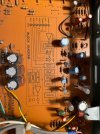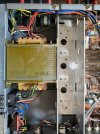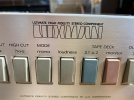Hi folks,
I come to this forum seeking some help beyond my knowledge to resolve a weird issue I´m experiencing in my Luxman L-1 amplifier.
It has worked pretty well during his more than 30 years of life. However, quite recently, it creates a very frustrating noise in both Phono an Subsonic mode.
However, in turner or auxiliary modes, it works smoothly.
I´ve tried to do all checks I could think of: RCA cables, ground, speaker cables, cleaning all the dust inside it, checking all connections and it seems to be OK. Nothing has happened in terms of impacts or any other unexpected event.
Please check the attached pictures and video with the noise, and suggest what else can I do. I really love this amplifier as it was originally from my father so I´d love to repair it.
Video with the noise

Thank you!









I come to this forum seeking some help beyond my knowledge to resolve a weird issue I´m experiencing in my Luxman L-1 amplifier.
It has worked pretty well during his more than 30 years of life. However, quite recently, it creates a very frustrating noise in both Phono an Subsonic mode.
However, in turner or auxiliary modes, it works smoothly.
I´ve tried to do all checks I could think of: RCA cables, ground, speaker cables, cleaning all the dust inside it, checking all connections and it seems to be OK. Nothing has happened in terms of impacts or any other unexpected event.
Please check the attached pictures and video with the noise, and suggest what else can I do. I really love this amplifier as it was originally from my father so I´d love to repair it.
Video with the noise

Watch WhatsApp Video 2022-03-13 at 4.45.12 PM | Streamable
Watch "WhatsApp Video 2022-03-13 at 4.45.12 PM" on Streamable.
streamable.com
Thank you!










